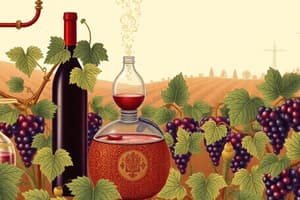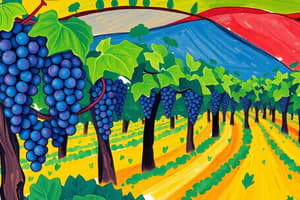Podcast
Questions and Answers
What is the primary process used to create wine from grapes?
What is the primary process used to create wine from grapes?
- Carbonation
- Fermentation (correct)
- Aging
- Distillation
Where has archaeological evidence suggested the earliest known wine production occurred?
Where has archaeological evidence suggested the earliest known wine production occurred?
- China and Egypt
- Iran and Armenia (correct)
- Italy and France
- Spain and Portugal
Which of the following regions in Europe has shown evidence of ancient wine production?
Which of the following regions in Europe has shown evidence of ancient wine production?
- France
- Northern Greece (correct)
- Spain
- Italy
In addition to grapes, what is a key element of the wine making process that influences the final product?
In addition to grapes, what is a key element of the wine making process that influences the final product?
What role did wine play in ancient Egyptian culture?
What role did wine play in ancient Egyptian culture?
What is the term used for the practice of preserving and enhancing wine amidst custom and tradition?
What is the term used for the practice of preserving and enhancing wine amidst custom and tradition?
Which of the following is a misconception regarding the historical production of wine?
Which of the following is a misconception regarding the historical production of wine?
Which type of evidence was uncovered in northern Greece that indicates early wine production?
Which type of evidence was uncovered in northern Greece that indicates early wine production?
What is the primary purpose of sulphur in the fermentation process?
What is the primary purpose of sulphur in the fermentation process?
During fermentation, which yeast strain is typically added to the must?
During fermentation, which yeast strain is typically added to the must?
What temperature range is ideal for fermenting red wines?
What temperature range is ideal for fermenting red wines?
What is the term used for the top portion of the wine that is collected after fermentation?
What is the term used for the top portion of the wine that is collected after fermentation?
What is the purpose of racking in the winemaking process?
What is the purpose of racking in the winemaking process?
Which substance can be used for finning to clear the wine's appearance?
Which substance can be used for finning to clear the wine's appearance?
What is the process of blending used for in winemaking?
What is the process of blending used for in winemaking?
What is the purpose of refrigeration in the winemaking process?
What is the purpose of refrigeration in the winemaking process?
Which disease causes powdery mildew that destroys grape flowers?
Which disease causes powdery mildew that destroys grape flowers?
What is the primary effect of Phylloxera on grapevines?
What is the primary effect of Phylloxera on grapevines?
Which method is suggested to prevent Pernospora attacks?
Which method is suggested to prevent Pernospora attacks?
What classification do wines without carbonation fall under?
What classification do wines without carbonation fall under?
Which type of wine undergoes carbonation during fermentation?
Which type of wine undergoes carbonation during fermentation?
What is the typical alcoholic percentage range for fortified wines?
What is the typical alcoholic percentage range for fortified wines?
Which disease can contribute positively to wine quality by concentrating the sugar content?
Which disease can contribute positively to wine quality by concentrating the sugar content?
Which of the following is a feature of table wines?
Which of the following is a feature of table wines?
What is the primary purpose of aging wine in oak barrels?
What is the primary purpose of aging wine in oak barrels?
What is the temperature maintained for storing wine in cellars?
What is the temperature maintained for storing wine in cellars?
What is the main sealing material used for wine bottles?
What is the main sealing material used for wine bottles?
Which of the following components is NOT typically included on a wine label?
Which of the following components is NOT typically included on a wine label?
What process is used to stop further fermentation in wine?
What process is used to stop further fermentation in wine?
What method refers to wine having carbon dioxide produced during fermentation retained in the bottle?
What method refers to wine having carbon dioxide produced during fermentation retained in the bottle?
Which type of wine benefits the most from maturation?
Which type of wine benefits the most from maturation?
How long are Bordeaux and Burgundy wines typically matured?
How long are Bordeaux and Burgundy wines typically matured?
What does the term 'Assemblage' refer to in the Méthode Champenoise production?
What does the term 'Assemblage' refer to in the Méthode Champenoise production?
Which of the following best describes 'Blanc de noir'?
Which of the following best describes 'Blanc de noir'?
What is the process of 'Dégorgement' in the Méthode Champenoise?
What is the process of 'Dégorgement' in the Méthode Champenoise?
What does 'Cuvée' refer to in the context of sparkling wine?
What does 'Cuvée' refer to in the context of sparkling wine?
What is 'Dosage' in the Méthode Champenoise?
What is 'Dosage' in the Méthode Champenoise?
'Tirage' is a term that refers to what aspect of the Méthode Champenoise?
'Tirage' is a term that refers to what aspect of the Méthode Champenoise?
What does the term 'Remuage' involve during the sparkling wine production?
What does the term 'Remuage' involve during the sparkling wine production?
What is the role of a 'Remueur' in the Méthode Champenoise?
What is the role of a 'Remueur' in the Méthode Champenoise?
Flashcards are hidden until you start studying
Study Notes
Wine Definition
- Wine is an alcoholic drink made from fermented grape juice.
- Wine production conforms to local practices and traditions.
Wine History
- Wine production has been practiced for thousands of years.
- The earliest known wine production occurred in Iran and Armenia around 8,000 BC to 6,000 BC.
- Ancient Greece has evidence of wine production dating back 6,500 years ago.
- Egyptian history records wine's role in ancient ceremonial life.
Grape Diseases
- Oidium tuckerii: A powdery mildew that affects flowers and can be prevented with sulfur spraying.
- Phylloxera: A root-eating aphid that weakens vines, impacting fruit production.
- Pernospora: A fungal infection that hinders photosynthesis, control with copper sulfate spray.
- Cochylis: Moths and caterpillars that consume leaves, combat with arsenic salt and nicotine spray.
- Gray Rot (pourriture gris): A fungal infection that affects fruit and creates an unpleasant odor.
- Noble Rot (pourriture noble): A fungal infection that results in concentrated sugar content, improving wine quality.
Geographic Conditions for Wine Production
- Enough sunshine to ripen grapes.
- Moderate winter temperatures.
- An average yearly temperature of 14-15 degrees Celsius.
Wine Classification
- Table Wines: Still wines that lack carbonation - further divided into dry and sweet categories.
- Dry wines have minimal sugar - ideal for meals.
- Alcoholic content ranges from 8.5% to 14%.
- Examples: Beaujolais, Chablis, Montes.
- Sparkling Wines: Wines with added CO2 for effervescence.
- Alcoholic content ranges from 9% to 14%.
- Examples: Moët & Chandon, Lanson, Cooks, Tattinger.
- Fortified Wines: Wines with added alcohol (usually brandy) during or after fermentation.
- Alcoholic content ranges from 15% to 22%.
- Examples: Sherry, Port, Madeira, Marsala.
Wine Making Process
- Sulphuring: Reduces oxygen content in must to prevent bacterial growth and vinegar formation
- Fermentation: Converts sugar into alcohol with the addition of Saccharomyces ellipsoids yeast.
- Temperature range: 64-70 degrees Fahrenheit for red wines, 44-59 degrees for white wines.
- Cellaring: Maturation in casks, filled to the top to keep out air. Provides age and character.
- Second Pressing: Additional juice extraction from fermented grape solids.
- Racking: Separating wine from lees (sediment) to avoid negative taste.
- Finning and Filtration: Clarifying wine to eliminate haze.
- Refrigeration: Stabilizes wine.
- Blending: Combining wines from different vineyards or years for consistency and taste.
- Aging: Maturation in oak barrels for a year or two.
- Bottling: Glass bottles are preferred, some are colored to protect from light.
- Corking: Cork is the best material for sealing bottles.
- Pasteurization: Stops fermentation by heating bottles at 180 degrees Fahrenheit for two minutes.
- Maturing: Further development of wine in the bottle, enhancing flavor.
- Labeling: Provides essential information about origin, region, quality, producer, alcohol content, vintage, and more.
- Storing: Storing wine in cellars at 12.5 degrees Celsius to preserve its quality.
Sparkling Wine Production
- Artificial CO2 Injection: Carbon dioxide is injected into table wine.
- CUVEE CLOSE (CHARMAT) Method: Second fermentation in a tank, followed by bottling under pressure.
- CHAMPANOISE Method: Second fermentation occurs within the bottle.
Terms Used in Méthode Champenoise Production
- Assemblage* - Preliminary blending of wines from different vineyards.
- Bead*- CO2 bubbles in the wine.
- Blanc de blanc* - Champagne made exclusively from white grapes.
- Blanc de noir* - Champagne made from Pinot noir grapes - may impart a light salmon color.
- Cremant* - Lightly sparkling wine with a creamy and frothy texture.
- Cuvée* - A specific blend used for sparkling wine.
- Dégorgement* - Removing sediment from the bottle during riddling.
- Dosage* - Sweetener added after disgorging.
- Liqueur de tirage* - Sugar mixture added for the second fermentation.
- Méthode champenoise* - Traditional champagne production method.
- Mousse* - Froth or foam in the wine.
- Pupitres* - Sloped racks used to hold bottles during riddling.
- Remuage* - Riddling or turning bottles to move sediment towards the cork.
- Remueur* - Person who performs the riddling process.
- Tirage* - Base wine and sugar mixture for second fermentation.
Studying That Suits You
Use AI to generate personalized quizzes and flashcards to suit your learning preferences.




